Once final frost has come and gone and the nights are consistently above 50 F, the soil is finally warm enough for the crops that thrive in the heat of summer.
Some of them, like tomatoes and ground cherries, absolutely must be started 6 to 8 weeks prior to final frost to have any chance of surrounding you with abundance in short seasons.
Others, like basil and cosmos, will surround you with abundance whether you transplant or direct sow them.
Here, friends, are the crops whose fragile, sensitive root systems despise being transplanted. When direct-sown, they’ll grow faster and fruit earlier, increasing your harvests significantly. (If you must transplant them, be sure to follow the tips on peat/cow pots and soil blocks at the bottom of the list.)
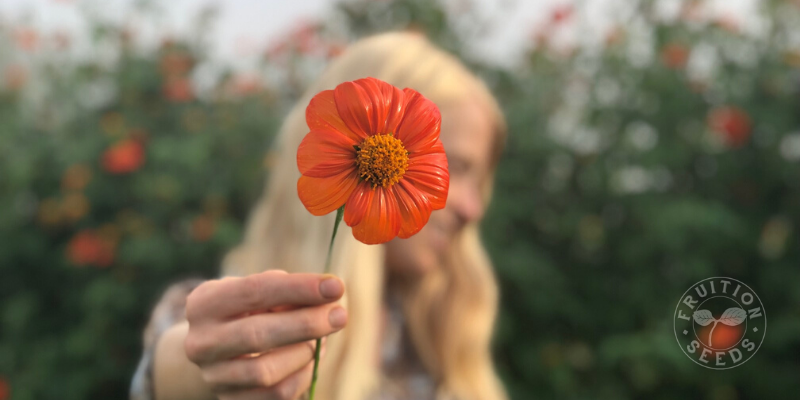
1. Cucurbits
A brush up on botanical Latin! The Cucurbit family classically sprawls and is slightly spiny, including everything from summer squash to winter squash, cantaloupe to cucumber.
As you’re planting cucurbits this season, keep in mind:
- cucurbits are heavy feeders; they’ll respond to any additional compost or fertility you offer them with increased abundance
- More sun = more fruit!
- Cucurbits can be trellised up and don’t worry about their fruit falling off the vine. The only exception is melons, whose thin, succulent stems often break once fruit becomes heavy.
- Floating row cover excludes insects from your crops and warms them, inspiring vigor and health. Specifically for cucurbits, excluding voracious cucumber beetles makes all the difference. Keep the row cover over your plants until they’re beginning to flower, making it easy for insects to pollinate your flowers.
- We love planting cucurbits on biotella. Hop on over to our video about combining biotella and floating row cover for the healthiest organic cucurbits!
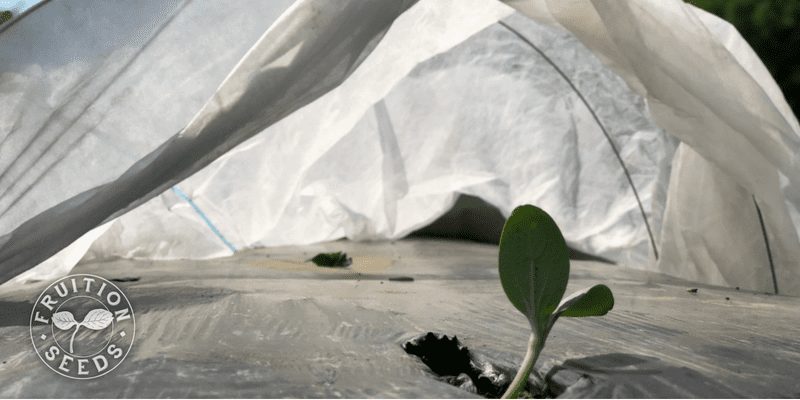
Cucurbits thrive when grown in biodegradable ‘biotella’ mulch with hoops supporting floating row cover above.
- Maintain minimum distances away from each other: The increased airflow will decrease their susceptibility to diseases like Powdery Mildew as well as make harvest more accessible. This distance is specific to each species and you’ll find them below.
- Poor fruit development in cucurbits is often either a nutrient deficiency (Neptune’s Harvest fish emulsion applied every two weeks is an easy way to avoid deficiencies) or indicate lack of pollination, which is only common when it pours rain for days on end.
Here is some more specific insight for some of our favorite Cucurbit crops:
Zucchini
Zucchini blossoms stuffed with herbed ricotta and their nutty, melt-in-your-mouth fruit on the grill grace our tables daily throughout the summer. Despite stories of neighbors stuffing abundant excess zucchini in unassuming mailboxes, there are definitely some tricks to growing your zucchini well for this and many seasons to come.
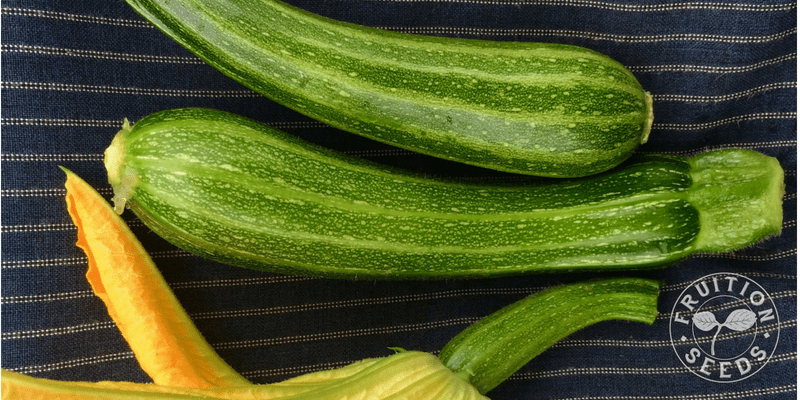
‘Cocozelle’ has rich, heirloom flavor rare in modern zucchini.
Plant zucchini as you would any cucurbit (see above) with 18 to 24 inches between plants to increase airflow and decrease susceptibility to diseases like Powdery Mildew.
Cocozelle is our go-to for old-time zucchini flavor and productivity. Success PM is a yellow squash that we love for its sheer abundance and Powdery Mildew resistance. Pattison Panache is a delightfully compact, delicious and prolific French heirloom patty pan.
If you want consistent summer squash through frost, sow your first succession after last frost and your next succession 4 to 5 weeks later.
Winter Squash
There are so many varieties of winter squash and there are so many ways to prepare it! On the grill, in the oven, in a pie or as a soup, it’s hard to have too much winter squash. A few things to keep in mind, so too much squash will be your reality:
A super small and super sweet butternut, Honeynut is perhaps my favorite winter squash of all time. That being said, a rainbow is more beautiful for all of its colors and we grow a rainbow of winter squash with the same philosophy. Whether it’s the storage and story of Sibley, the early fruits with edible skins of Delicata, the exceptional beauty of Winter Luxury pumpkin or the refined versatility of Gouda, flavor and diversity keep us well-fed in body and spirit throughout the seasons.
Because winter squash often has over 100 days to mature, there is no ‘succession sowing’ of winter squash. Simply sow its seeds after final frost and pay attention to ‘days to maturity’ on your seed packet: if a variety is over 120 days, you’re taking a risk of too short a season here in Zone 5. Little tricks like biotella mulch and row cover go a long way to extend the season though, especially if you don’t have a greenhouse or high tunnel.
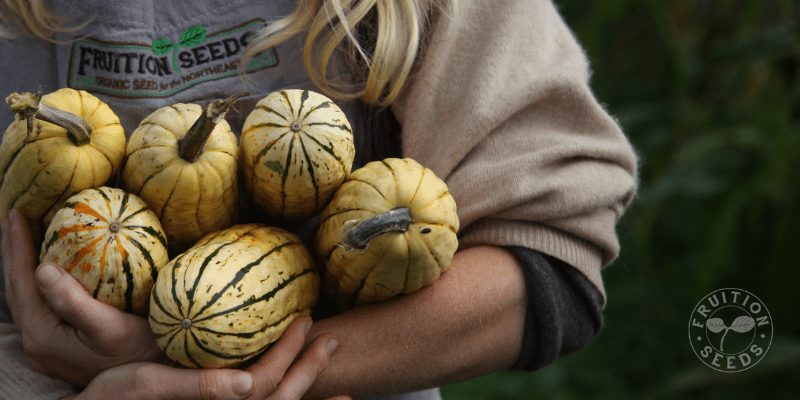
Delicata is beloved for its early fruit and tender, delectable skin.
Cantaloupe & Watermelon
Regional adaptation yields greater abundance for all crops, but for some it is absolute necessity. Like melons, for example. Growing up in my father’s garden here in the Finger Lakes, I thought we just couldn’t grow watermelons. The season was too short and too cool, and besides, if a plant is going to take up THAT much room, it should produce at least two melons. Is that too much to ask? Finally, on a farm in Maine, I ate Sugar Baby, a short-season ice-box style watermelon, and realized I had simply been growing poorly adapted seeds, all these years.
Here is a sneak peak at August Ambrosia, one of Fruition’s new varieties bred right here on our farm with the help of Michael Mazourek of Cornell.
Three to four feet between plants increases airflow and decreases melon susceptibility to diseases like Powdery Mildew. Ample water is key for optimal fruit development. Resist watering one week before fruits mature to concentrate flavor and decrease chances of cracking.
Sugar Baby, with its full sweetness, crisp, juicy texture and consistent productivity, is the most reliable of all short-season red watermelons we’ve grown. Stay tuned for some exciting new releases next season, though. (One is an heirloom we were recently gifted and the other is a brand new variety we’ve been selecting for years.)
In the world of cantaloupe, Delicious 51 was developed at Cornell (in 1951, you guessed it). With it’s early maturity and Powdery Mildew resistance, it’s still as relevant as it was all those years ago. Other melons we grow without attachment to outcome; Delicious 51 is our go-to for reliable, luscious cantaloupe throughout August, without fail.
Similar to winter squash, ‘days to maturity’ make all the difference if you want to mature melons in short seasons. As a result, we really don’t succession sow melons, though we have friends that do plant a second succession 2 to 3 weeks after the first. If eating fresh melon daily for over 6+ weeks is why you garden, make space for that second succession. And again, biotella mulch and row cover are easy ways to increase your harvest, especially if you don’t have a greenhouse or high tunnel.
Cucumber
If you don’t already know, now you do: I take savory over sweet any day. And I love cucumbers more than I know how to reasonably talk about.
Silver Slicer, my favorite cucumber of all time, is the delicious and disease-resistant genius of Michael Mazourek, an organic plant breeder at Cornell.
Grow cucumbers as all cucurbits (see above), allowing 2 feet between plants to increase airflow and decrease their susceptibility to diseases like Powdery Mildew. Once your cucumbers are flowers, ample and consistent water will yield the sweetest, most abundant harvests.
If Powdery Mildew arrives consistently in your garden (as it does ours), know there are many things you can do to prevent it. By far the best: Grow disease resistant varieties. We have six Powdery Mildew-resistant cucumbers, including the darling and utterly disease-resistant Mouse Melon or Mexican Sour Gherkin, my second favorite cucumber of all time.
If your space is limited, or if containers are your style, bush cucumbers will change your life. So long as they have abundant nutrients, you’ll harvest no less fruit on a 2′ vine instead of a 5′ vine. Think of all the extra food you can be growing in that space! Have fun experimenting
If you’re committed to swimming in cucumbers this season, succession sow. Your first succession will be right after last frost. Three to four weeks later, sow your second succession. Six weeks after the first, sow your third succession. Resistance to disease is increasingly imperative for your successions of cucumbers to, indeed, succeed. And yes, it is so worth it.
2. Beans & Peanuts
Beans and peanuts, as members of the massive and diverse legume family, create their own nitrogen. While squash and corn, tomatoes and eggplant thrive most in the rich soil, legumes generally make do and even thrive in average, less fertile soils.
For more abundant beans this season:
- Sow any bean or peanut seed in rows every 3-4 inches, thinning to 1 plant every ~6 inches.
- Sow with inoculant (microbe-rich powder full of their symbiotic, nitrogen-fixing bacteria) to increase health and yield, especially if you’re planting legumes in a place that may not have grown legumes for a decade or more. If legumes have grown there more recently, you likely have an abundance of symbiotic bacteria still residing in your soil. We always add a touch of inoculant, just in case.
Dragon Tongue is a romano wax bean with rich flavor and incredible succulence.
- Bush beans are one of the easiest vegetables to grow, only getting about two feet tall. Pole beans are also easy, though they require solid six foot (or taller) trellising, which corn and sunflowers can provide as easily as wire or wood.
- In terms of harvest, you can expect a similar quantity from both and here’s the difference: the bush bean will bear it’s abundance in a few concentrated weeks while the pole bean will offer its abundance throughout the season. If you’re making dilly beans or putting away serious beans for the freezer, you want the harvest all at once. You want bush beans, for sure.
Provider is aptly named and will, in fact, furnish you with remarkable abundance all at once. Its dark seed coat allows it to germinate in slightly cooler soils, as well. If lots of beans all season long is your goal, without taking up tons of space with pole beans, grow 2 to 3 successions of bush beans. The first succession is sown just after final frost with each succession being sown 3 weeks after the last through late July, here in Zone 5.
If flavor is your top priority, followed by tenderness and succulence, sow the haricot vert-style Tavera, the romano Dragon Tongue or the surprisingly sweet Gold Rush as your bush beans. Scarlet Runner will forever be my favorite pole bean with massive, scrumptious pods, though Supermarconi is a marvelous green romano and Pink-Tip Greasy is inspired by haricot vert, with even smaller pods and even more nut flavor.
Peanuts! Are surprisingly easy to grow! Just be sure to sow seed well-adapted for short seasons.
In my father’s garden, in my childhood, we eagerly planted peanuts. Once. I loved watching their purple peduncles fall from canary yellow flowers, forming peanuts once they reached the shaded soil below. But once we harvested them, after first frost, and found 4 small shells with poorly formed nuts inside, I vowed never to waste precious garden space again. Leave peanut-growing for our friends below the Mason-Dixon.
Decades later, we were gifted peanuts that had been ‘adapted for short seasons’ in a home garden in the Upper Peninsula of Michigan. We decided to disavow my vow. After all, I believe regional adaptation is significant, so significant that we started Fruition Seeds.
Low and behold, though 2013 was the coldest summer on record, these ‘Northern Hardy Valencias’ still averaged 21 sizable peanuts per plant. In 2016, the warmest summer on record, they averaged 41 peanuts per plant.
Friends, dare to believe what you want to believe.
And then do little things, every day, like that beloved man in Michigan, to stretch your imagination and make possible what is possible in the world.
We can grow peanuts here in the Northeast, do not doubt.
You just need the right seeds.
Finally, hyacinth beans can be direct sown after final frost. Though ornamental, their striking foliage, lilac flowers and luminescent pods will feed your hummingbirds and butterflies all season long. If you trellis them 30′ up your cobblestone home, as Roger does, know they won’t disappoint you.
Our hyacinth beans come from a handful of seeds, gifts from our dear friend Roger B. Swain, who has grown them for decades in New Hampshire.
3. Cilantro & Dill
I cannot imagine summer without cilantro. Or life without dill.
Their flavors, so distinct and so delectable, are best enjoyed fresh. We go to great lengths to be sure we can harvest them abundantly, and incessantly, all season long.
To enjoy consistent harvests of cilantro and dill all season long, you’ll need to succession sow them every 2 to 3 weeks.
For cilantro that bolts less quickly:
- Only direct sow
- Offer ample, even water, especially just before harvest to inspire quick re-growth and
- Know cilantro will bolt less in the cold. We sow cilantro in fall, harvesting some in fall and again after the snows melt, often for several cuttings. In summer, succession sowing is a necessity.
- For dill that bolts less quickly, do the same but know it is frost-sensitive.
4. Carrot & Beet
In salads, slaw, sauteed, roast or on the grill, I’m utterly in love with root vegetables. Sweet and crunchy yet rich and earthy, we go out of our way to ensure an abundance of root vegetables, especially beets and carrots, throughout the seasons.
We sow Detroit Dark Red Beet from mid-April through mid-August here in Zone 5.
Carrots and beets are so rewarding, though certainly they are not the easiest vegetables to grow. Here are a few tips:
- Roots thrive in rich, loose soil
- Maintain consistent moisture to inspire even, abundant and early germination
- Thin them as soon as their first true leaves appear (and enjoy this video to demonstrate)
- Continue to thin them as the weeks go by, enjoying the baby roots as you make space for your longest, widest roots
- Sow every 2 to 3 weeks for abundant, consistent harvest from ~4 weeks before final frost in spring to ~6 weeks before first frost in fall
5. Corn
From a grass in the Peruvian Andes 6,000 years ago to millions of acres of towering across 6 continents today, corn feeds us every day in myriad forms. Home-grown corn, whether it’s sweet on the cob or dry for polenta, is both irresistible and irreplaceable.
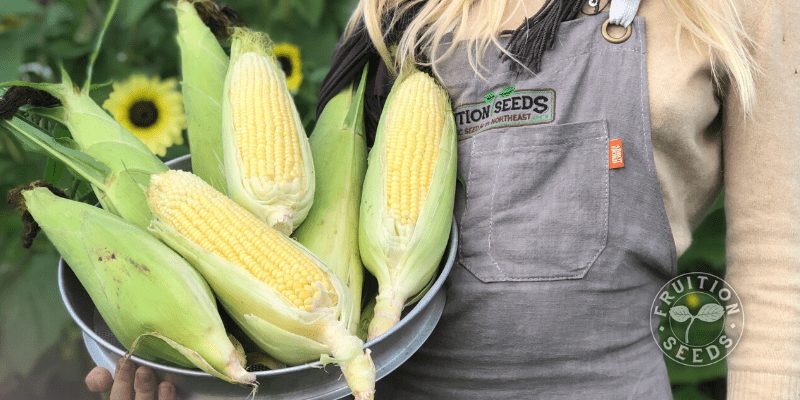
Double Standard is a luscious sweet corn we love to grill.
As you’re planting corn this season, keep in mind:
- Corn is an impressively heavy feeder, so don’t skimp on the compost.
- For full ears of gorgeous kernels, you’ll need at least 20 plants to pollinate each other.
- Corn grown in a block will pollinate better than corn grown in a row.
- Corn can be sown 1 to 2 weeks prior to last frost.
- Sweet corn, with shorter days to ‘edible maturity’ than flour corn, may be planted in successions. We recommend sowing every 2 to 3 weeks through mid-July for sweet corn through frost, here in Zone 5.
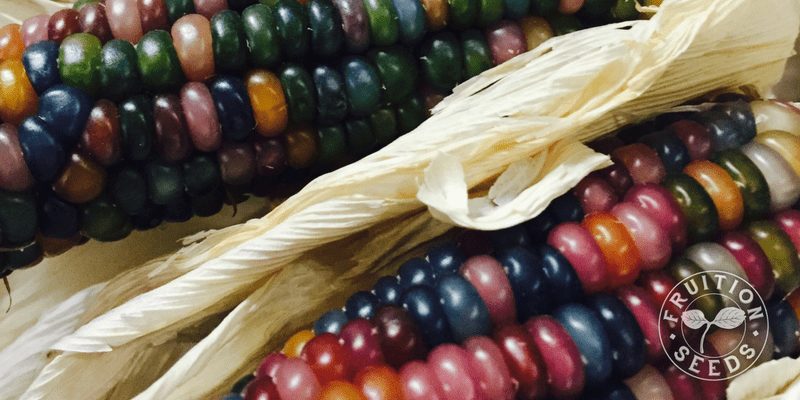
Glass Gem is outrageously gorgeous. Its ground polenta is nutty and rich, a light pewter-purple, if you can stand to eat it!
- Crows marauding your germinating, sprouting corn can be a persistent nightmare. The easiest, most consistent deterrent for crows eating baby corn is simply covering your beds with floating row cover. This also increases the heat underneath it, inspiring your corn to grow faster.
Fisher’s Earliest, with its balance of savory, old-time corn flavor and sweet, is our favorite sweet corn. If you have a sweet tooth, and I don’t blame you, grow Double Standard. If you’re growing a three sister’s garden, grow full season Italy Hill popcorn or Glass Gem for polenta and awe.
6. Sunflower
Most flowers are best transplanted.
Some will thrive direct sown or transplanted.
There are few flowers that genuinely prefer to be direct sown.
If there is one, sunflower surely is it.
Lemon Queen, towering over your garden, makes a marvelous pole bean trellis.
A few tips for sunflowers:
- Sow in groups of 2 to 3 seeds, 1/2 inch deep, no closer than 1 foot between groups. Thin to the strongest one once true leaves appear.
- Excess nitrogen inspires vigorous, tall growth that may not support itself. It also encourages flower shape abnormality, which can be fun, but will most likely be disappointing.
- More sun = more blooms!
- If chipmunks and squirrels eat your sunflower seeds and seedlings, know you’ll likely have no trouble growing Mexican Sunflower:
Your hummingbirds will love Tithonia as much as you will.
Also called Tithonia, this is an entirely separate genus/species than classic sunflower. It’s bitter and hairy by comparison and, friends, I am confident your resident rodents will not be tempted to devour them.
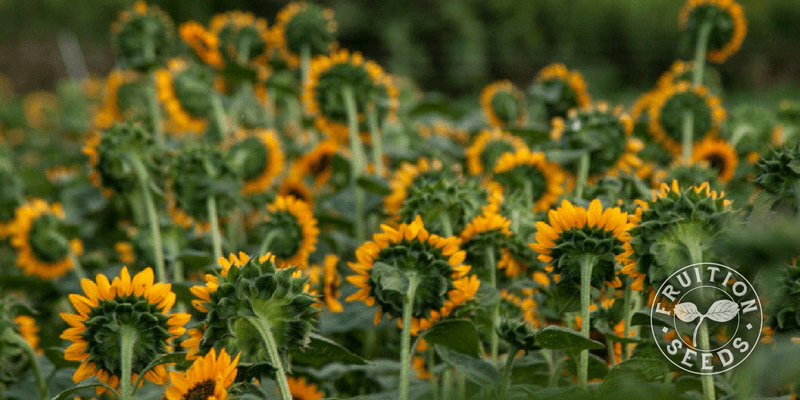
Sonja is 3 feet tall, often with 20+ strong secondaries perfect for cutting.
- For cutting gardens, container gardens or small gardens that can’t afford the shade, know there are dwarf sunflowers to surround you with beauty and abundance.
True (Transplant) Confessions
It’s time I confess: we actually do transplant a fair number of these crops that despise being transplanted, especially cucurbits.
Why Transplant?
a) It’s really nice to simply tuck in transplants, put row cover on and not have to come back to thin them a week or so later. The more row cover can completely envelop your seedlings, the faster they’ll grow and errant pest insects won’t have a chance to dine on them.
b) Transplants outcompete weeds much faster than their direct-sown neighbors, which is valuable even if you mulch but especially if you don’t.
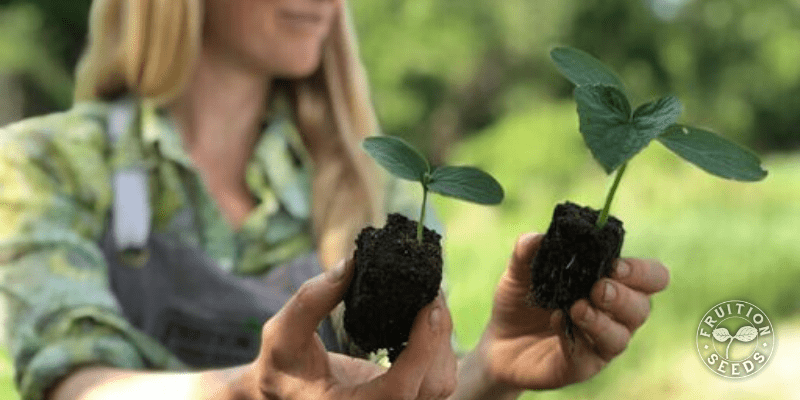
The cucumber on the left is ideal to transplant; the cucumber on the right, with full true leaves, is far too large and will yield much less.
How to Transplant Those Who Prefer to Not Be Transplanted
You’ve got two options that will set you up for success, soil blocks and peat/cow pots.
Here are the keys:
- Use awesome seed starting soil
- Transplant them no later than 10 days after you sow them
- Transplant before the first true leaf fully emerges
- Dunk them in water, or even better, diluted fish emulsion before transplanting
But most sincerely, resist transplanting these crops as much as you possibly can: It’s hard to nail it and their abundance is directly affected.
Enjoy every moment of June, Friends!
Sow Seeds & Sing Songs,

and the Many Beings of Fruition

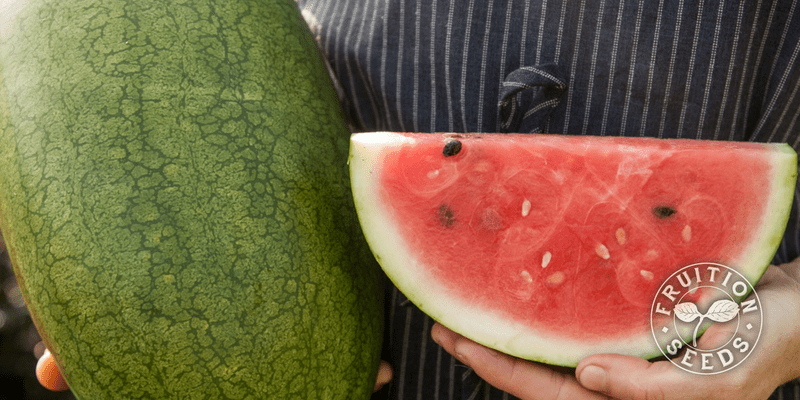
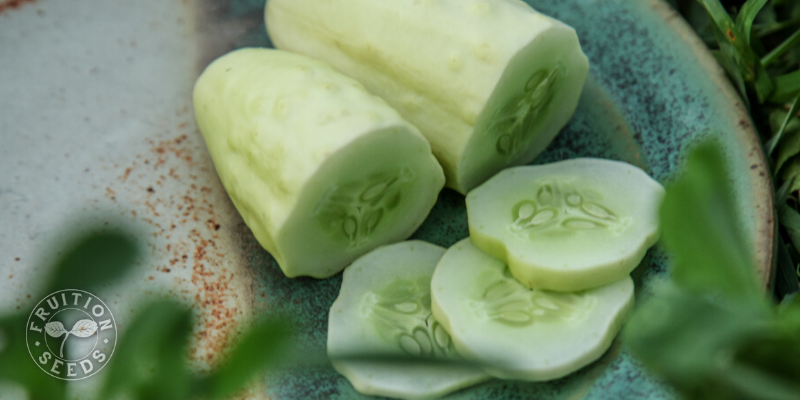
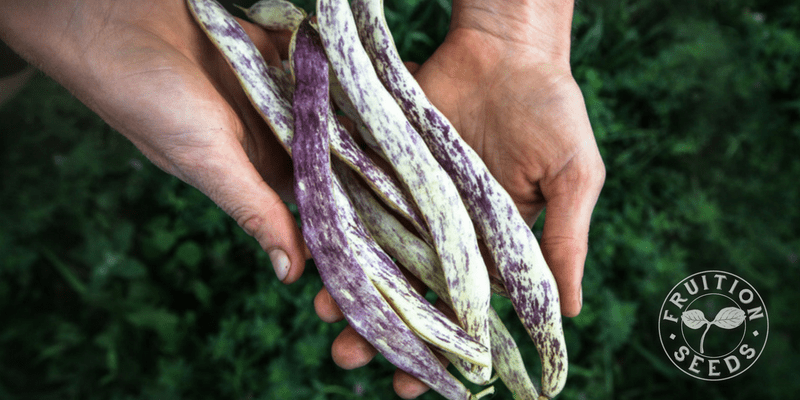
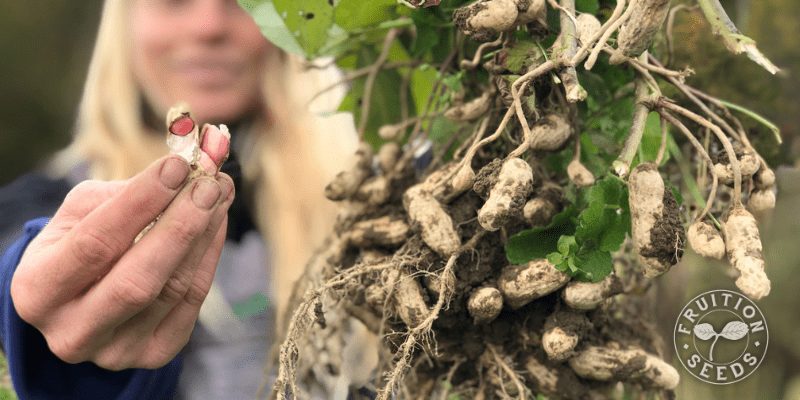
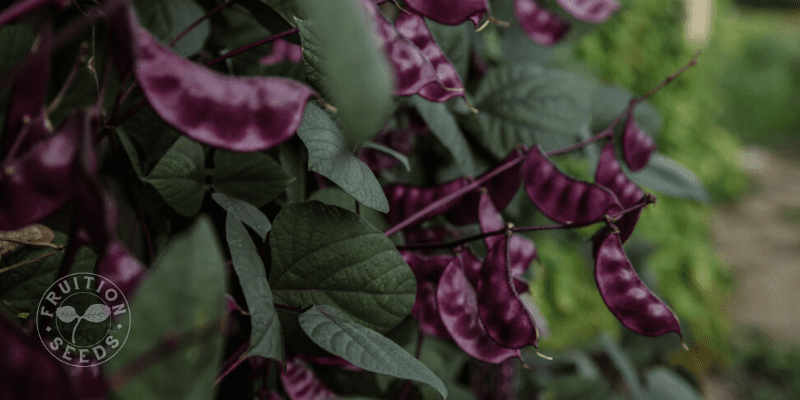
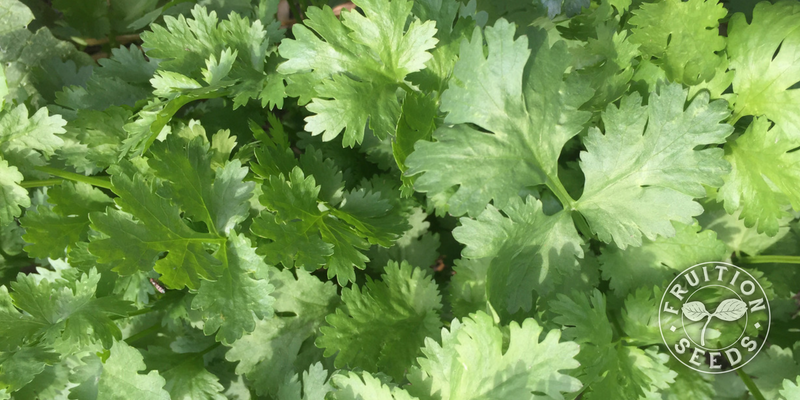
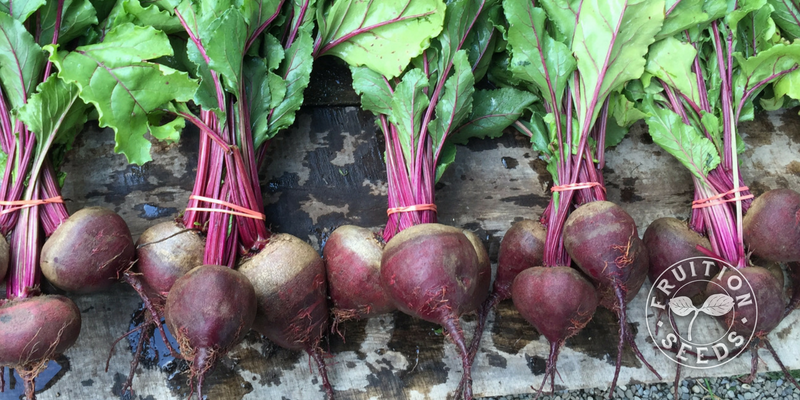
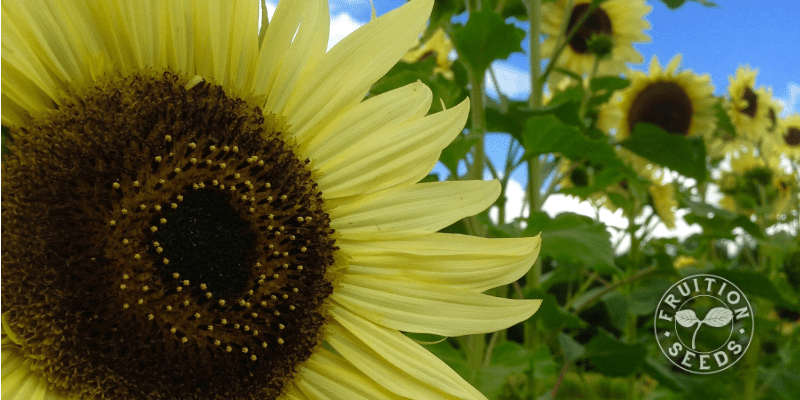
Petra –
The leaves on our tomato plants, in raised beds, are curling. Might you have any advice for us?
We live in CT and we are so enthralled with your video tutorials.
Thank you for anything you might be able to provide for us.
Our best –
Cheryl and John
this can sometimes be due to heat or lack of water stress
Thank you so much for this information! I was wondering if I still need to harden off the cucumbers if I transplant them before their 1st true leaf emerges? Also, is this also true for melons (ie transplant before the 1st true leaf emerges)?
giving any plant a day or two to acclimate to its new home before planting is always a nice idea, but plants are resilient! It really depends on what environment you are moving them from. the more dramatic the more they appreciate some slow introduction even a day or two.